
Understanding the challenge of Shadow AI
Shadow AI – a dramatic term for a new problem. With the rise of widely available consumer level AI services with easy-to-use chat interfaces, anyone from the summer intern to the CEO can easily use these shiny and new AI products. However, anyone who’s ever used a chatbot can understand the challenges and risks that tools like this can pose. They are very open-ended, sometimes not very useful unless implemented properly (remember SmarterChild??) and the quality and content of responses heavily depend on the person using them.
Many companies today are unsure how to regulate their employees’ use of these tools, particularly because of the open-ended nature of interaction and the lightweight browser-based interface. There is the risk that employees enter confidential or sensitive information, and an InfoSec team would have no visibility into it. Currently, there is almost no regulation around what can be used as training data for AI models, so one should assume anything put into a chatbot is not just between you and the bot.
As there is nothing running locally on machines, InfoSec teams then have to get creative in managing use, and a majority of teams are unsure how widespread the issue actually is.
Mitigating the risks
As these services are so lightweight, companies are left with few options to mitigate their usage. Of course one could use firewalls to block any network traffic to OpenAI and the like, but as companies look to take advantage of the benefits of this technology, no InfoSec or security team wants to be the department of 'no'. So how can one weed out the potential harmful situations where employees may be putting sensitive information in places they shouldn't from the beneficial and safe uses of AI?
The short answer is that you can’t truly block all employee usage of AI services, and so a holistic governance and security policy is the best way to achieve a good level of security. Internally at Rapid7, we have developed a comprehensive system of controls based on AI TRiSM (Trust, Risk, Security Management) to engage all employees in the security practices needed to keep our resources safe. This ebook outlines some of the ongoing projects to develop secure AI at Rapid7. But in addition to developing secure code, all employees at a company must be invested in keeping their infrastructure secure.
Implementing trust and verification
Even with all employees on board with these security measures, trusting but verifying is still important. Rapid7’s InsightIDR technology helps organizations pinpoint unacceptable uses of AI technology. Using SIEM technology such as InsightIDR’s Log Search and Dashboarding capabilities, users can easily build out views to track this behavior. InsightIDR also has behavioral analytics injected into each log – using host-to-IP observations and authentication patterns to identify which user is performing actions.
In this blog, we’ll outline how to use InsightIDR to detect shadow AI use at your organization.
Detecting Shadow AI with InsightIDR
The use cases outlined here primarily use DNS logs to search for domains affiliated with the most popular AI services like XYZ. We’ve put together a list of common AI technologies to get started, and you can utilize this method to extend to additional technologies that are applicable for your company.
Starting with a list of domains known to be associated with AI services:
AWS SageMaker
sagemaker.amazonaws.comapi.sagemaker.amazonaws.comruntime.sagemaker.amazonaws.coms3.amazonaws.com(for storing datasets and models)
Google AI Platform (Vertex AI)
ml.googleapis.comaiplatform.googleapis.comstorage.googleapis.com(for storing datasets and models)
Azure Machine Learning
management.azure.comml.azure.comwestus2.api.azureml.msblob.core.windows.net(for storing datasets and models)
IBM Watson
watsonplatform.netapi.us-south.watson.cloud.ibm.comapi.eu-gb.watson.cloud.ibm.comcloud.ibm.com
Other Common AI Service Domains
- OpenAI:
api.openai.com - Hugging Face:
api-inference.huggingface.co - Clarifai:
api.clarifai.com - Dialogflow (Google):
dialogflow.googleapis.com - Algorithmia:
algorithmia.com - DataRobot:
app.datarobot.com
The easiest way to build dashboards and queries to find instances of network activity to these services is to first create a variable to track this activity, and then to use that variable in your queries.
- Navigate to Settings → Log Management → Variables → Create Variable.
Here my variable name is “Consumer_AI”. Note: variables are case sensitive when referenced in Log Search. I added all domains as a CSV list. Again, this list can be edited per an individual organization’s needs.
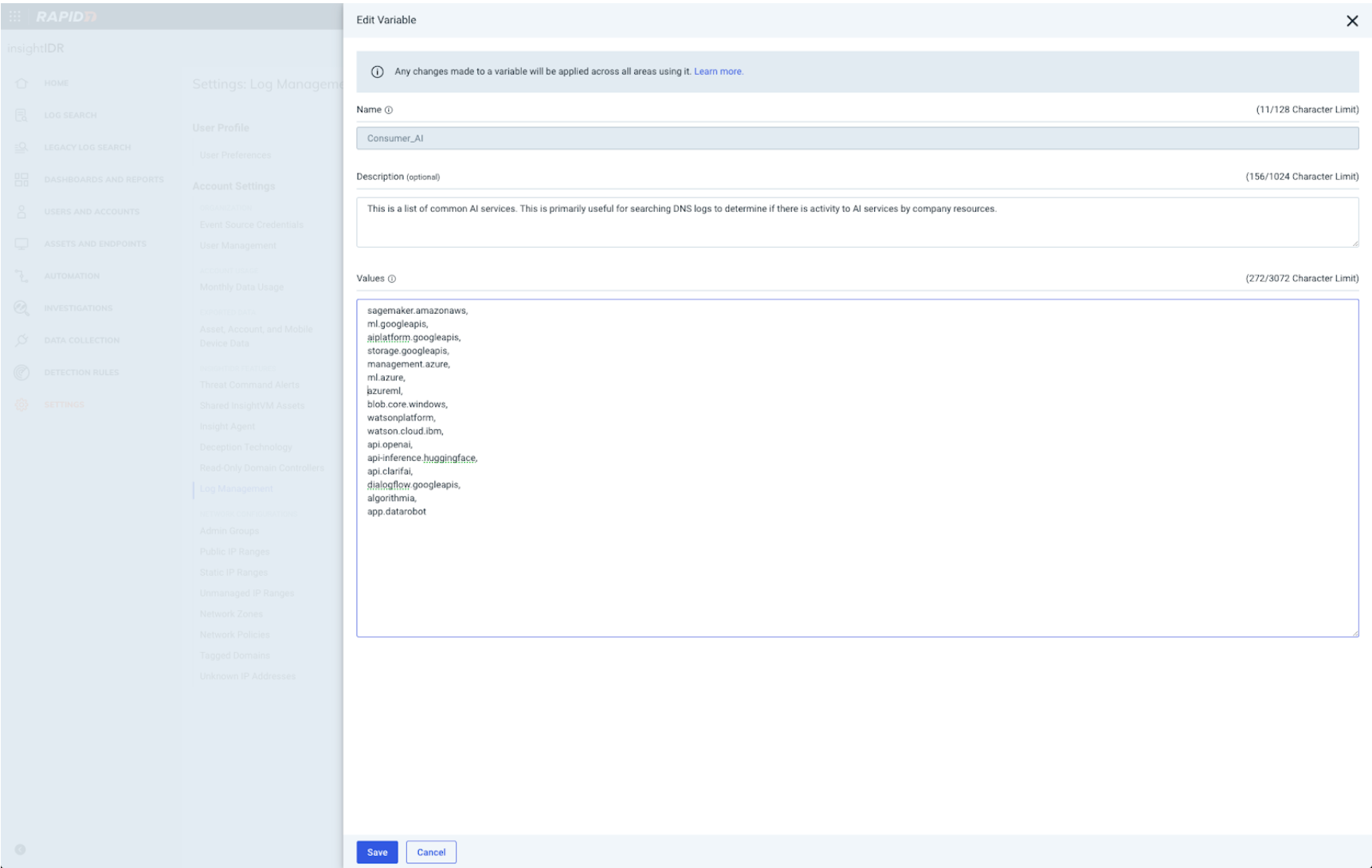
2. Navigate to Log Search, select any relevant DNS event sources, and use the query where(query ICONTAINS-ANY [${Consumer_AI}]).
This LEQL query will filter on anytime the “query” key matches a specified value. The “ICONTAINS-ANY” operator is a streamlined way to return log events where the values contain specified text values, particularly where there is a list of possible values. The “i” at the beginning of the phrase indicates that the search is case-insensitive. So the LEQL query reads that it is searching for any log events where the query contains any one of the CSV values listed in the variable named Consumer_AI, regardless of upper or lower case.
It is useful to use “CONTAINS-ANY” as opposed to “=”, as then the DNS query will still match even if there are appended domain prefixes or suffixes (for example, the value in the variable is “watson.cloud.ibm”. If the “=” was used, it would need to be an exact match. With the “CONTAINS” operator, a partial match is still valid, and so the result where "query": "api.us-south.watson.cloud.ibm.com" is returned.
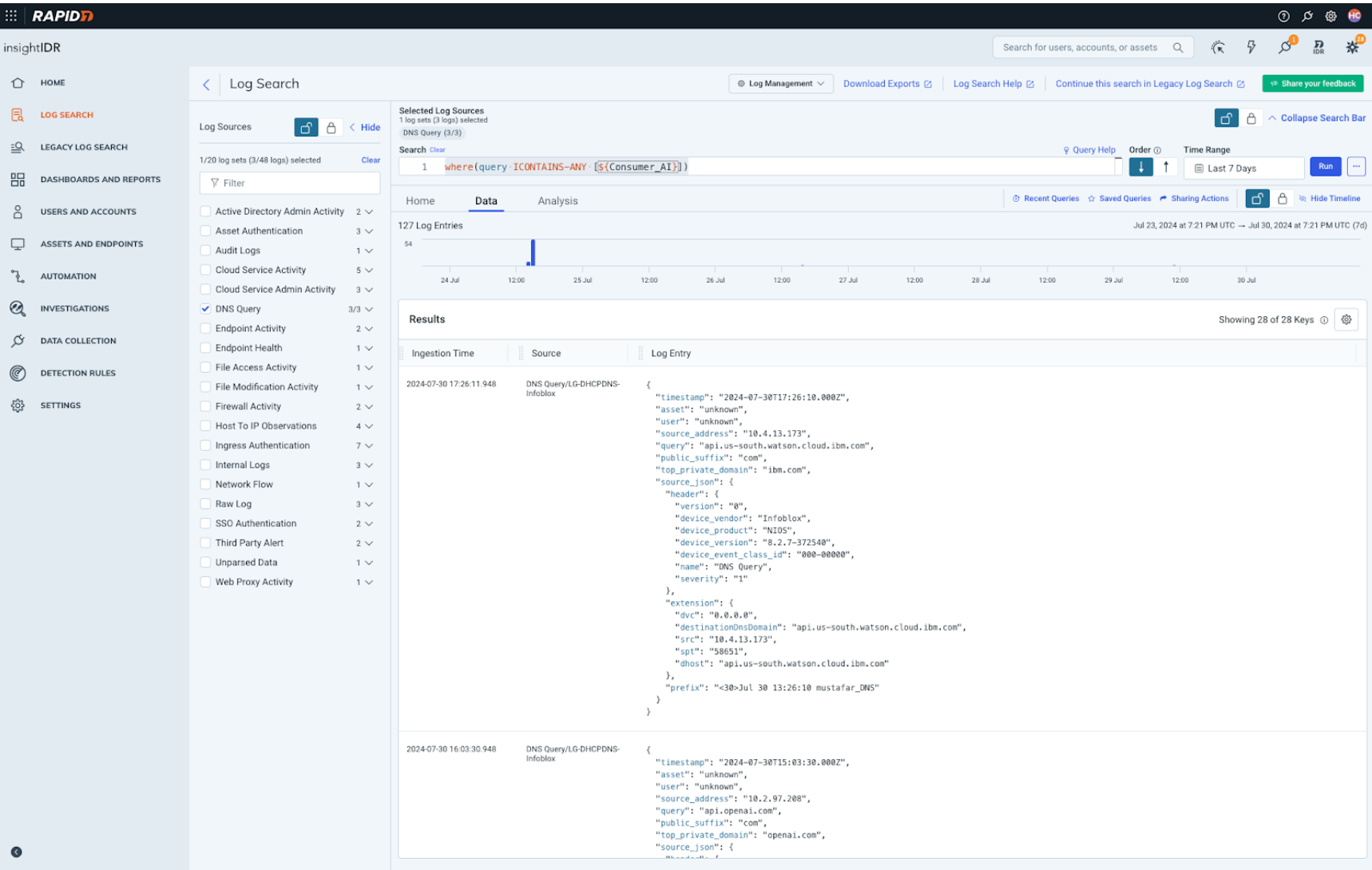
Now that we have a working query, this can be more easily digested by human eyes via a dashboard.
3. Navigating to Dashboards and Reports → New Dashboard will create a new dashboard that can be populated with relevant cards.
Next, using Add Card → From Card Library, we can use existing DNS Query templates to build our custom cards. I added all 5 DNS Query cards.
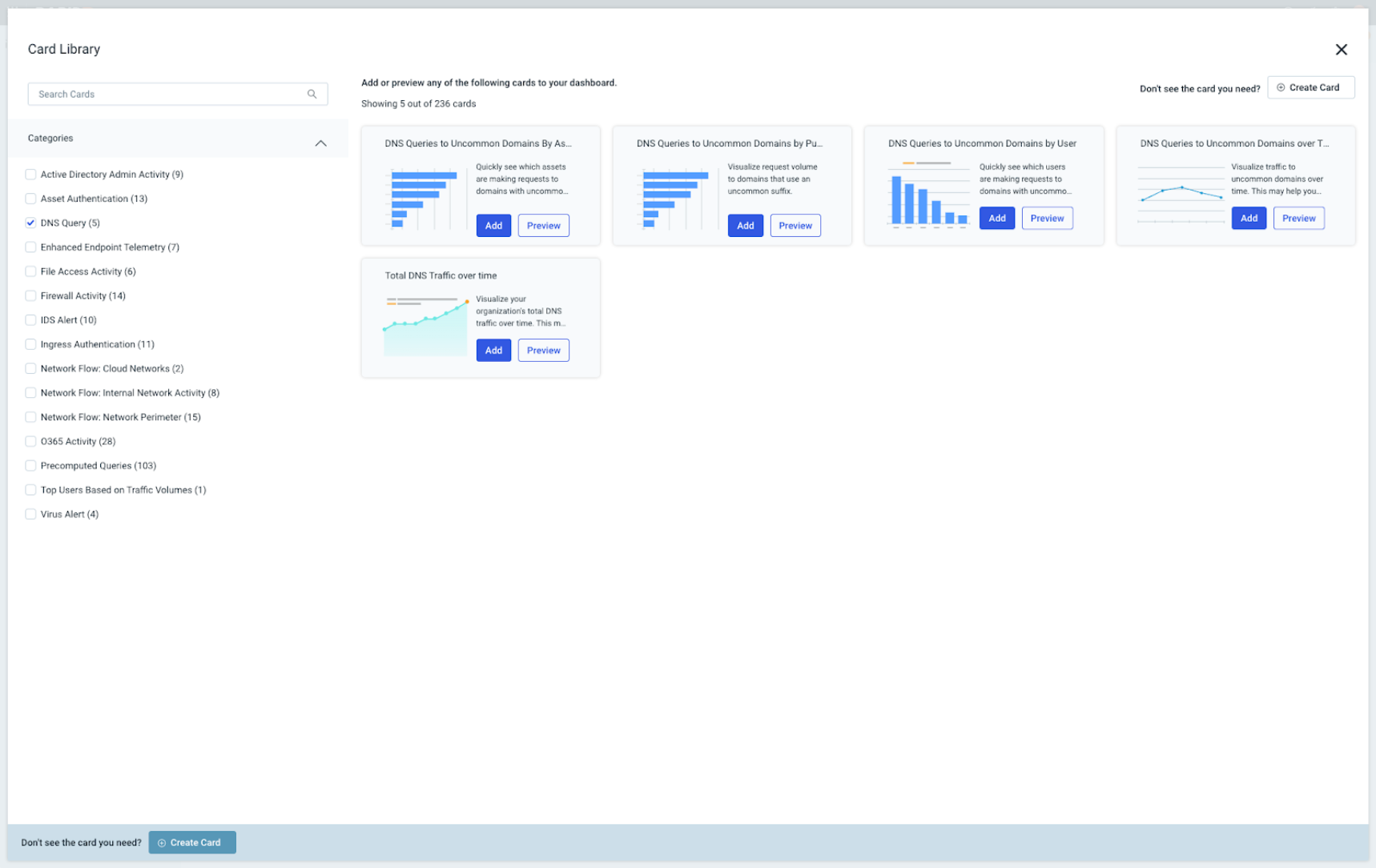
4. Edit the cards to query for AI usage instead of uncommon domains.
Plugging in the query that we built above but keeping the calculate(count) timeslice(60) syntax will allow the query to create a visual representation of DNS activity to those domains over time, with a time division of 60 seconds. This means that in a 1-hour time period, time is sliced into 60 intervals (so each timeslice is 1 minute each).
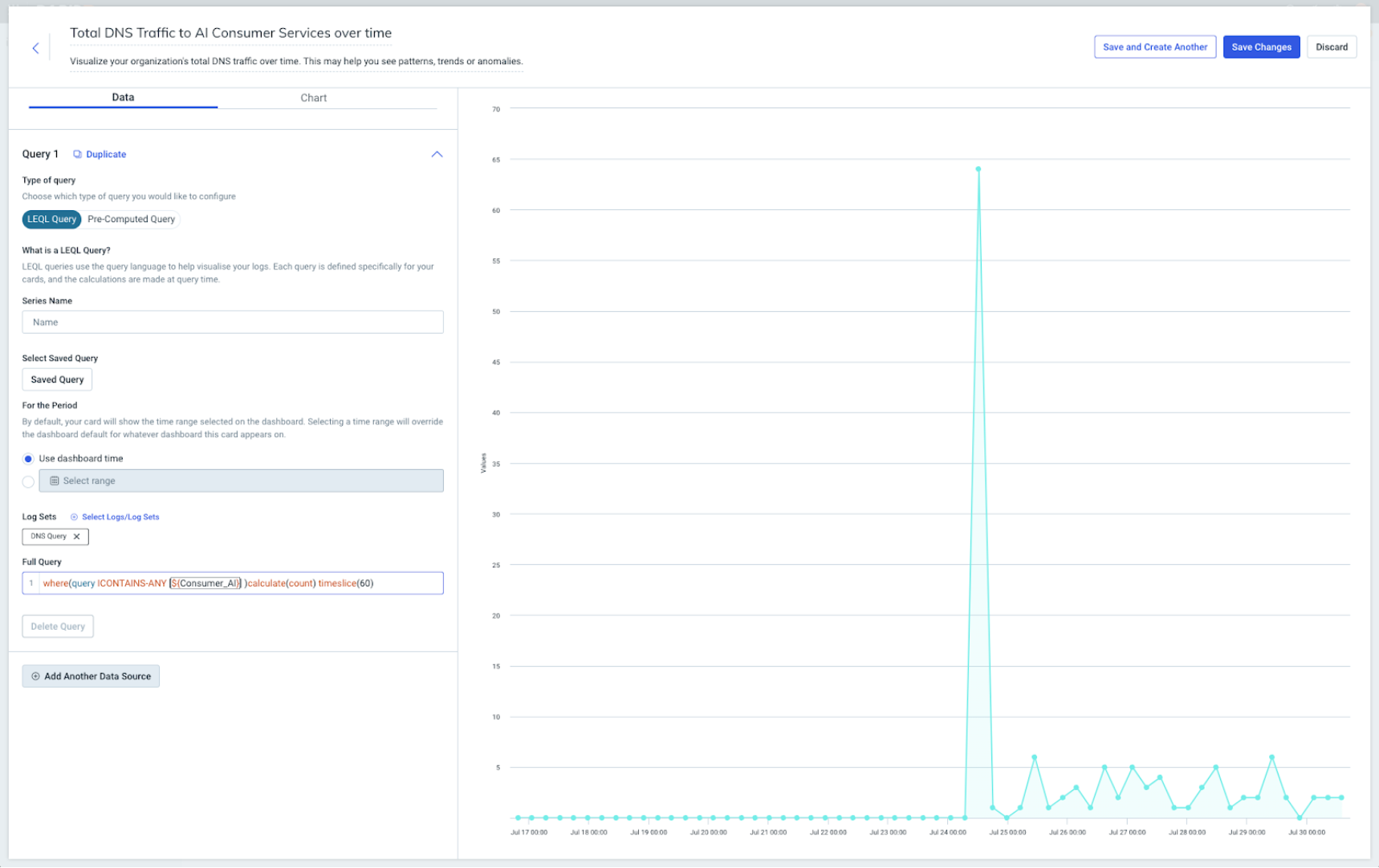
Enhancing user accountability
Now, you can go through the rest of the dashboard cards and edit them to accommodate the correct titles and descriptions of the cards. If you are worried about a particular website, this card is an example of how individual domains can be tracked:
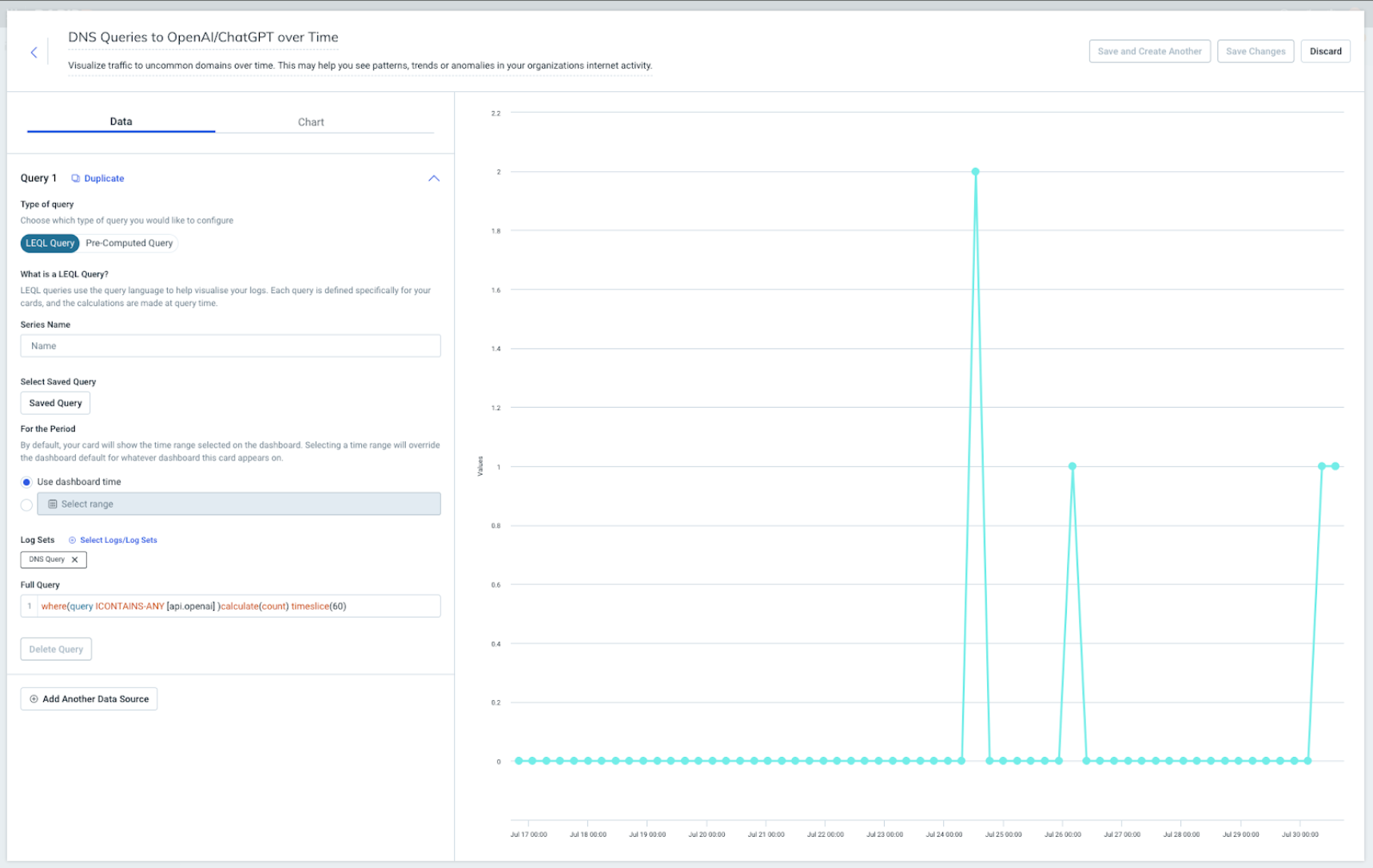
InsightIDR event source parsing does much more than just breaking a log entry into JSON. It uses UEBA to tie assets to users, and allows you to then understand exactly which users are responsible for network activity. Once you have that sort of visibility, you can drive accountability for those who choose to use AI services. This is pivotal for analysts – without this sort of correlation, analysts are left to decipher who owns which asset, a time-consuming process that can eat into precious response time. By injecting users’ names and information into logs searchable with InsightIDR’s Log Search, analysts can now create queries, dashboards, and alerts to track this activity directly back to individual users.
Here at Rapid7, we have used automation via InsightConnect to close the loop and keep our employees accountable for their browser-based activity. Once a user is identified as having navigated to an AI tool for the first time, they will get a Slack notification to remind them about our AI policy. This will continue to ping them until they review the policy.

Developing an AI policy
The Rapid7 AI policy was created in conjunction with our AI Center of Excellence and Legal teams. As with all acceptable use policies we develop here, it is meant to be an easy read – taking time to define potentially ambiguous or colloquially used phrases, so that employees have no excuse not to read and internalize it. One of the core values at Rapid7 is “Challenge Convention”. This does not mean that we are throwing caution to the wind when adopting new technologies, but rather to challenge old ways of thinking and forge new paths with foresight, discipline, and determination.
AI technology holds huge capabilities for teams to boost efficiency and supercharge their ability to make fast impacts across the organization. Security teams, tasked with ensuring that sensitive information isn’t exposed to a publicly facing LLM, can enable the safe use of AI technology by shining a light on the use of shadow AI.
Source: Rapid7
Source Link: https://blog.rapid7.com/2024/08/08/managing-the-risks-of-shadow-ai-in-modern-enterprises/